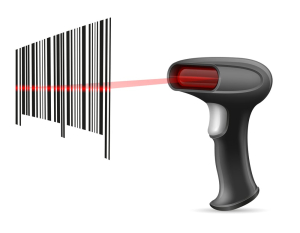How does a Barcode Scanner Work?
Ever wondered about the magic behind a barcode scanner? This blog unveils the intricate process that powers this seemingly simple yet highly impactful technology. Barcodes, often underestimated, have significantly transformed daily life, especially in the retail sector. The features of barcode readers are impressing small to large businesses and it has thus become a basic need to install Barcode Scanning Systems.
Come, let’s see how does a Barcode scanner works?
What is a Barcode Scanner?
A Barcode Scanner, or barcode reader, is a device equipped with essential components:
- Light Source: Illuminates the barcode for readability.
- Lens: Reads the code.
- Photoconductor: Converts optical information into electrical signals.
- Decoder: Interprets signals and transmits data to the business’s system.
Together, you can call it a Barcode Scan Engine that scans/reads the code via hardware to software. Barcode solutions are thus a combination of physical devices and software.
Varied Types of Barcode Readers
Depending on business needs, various types of barcode readers exist:
- Handheld: Corded or wireless, the most common type.
- Mobile Computers: Cordless with an in-built computer for code processing.
- Presentation: Hands-free scanners for swift multiple-item scans.
- In-counter: Set into kiosks or counters for seamless integration.
- Fixed-mount: Sensor-based readers in factories and processing centres.
- Wearable: Mounted on the body, often on fingers or arms.
- Mobile: Modern invention using mobile phones and barcode reader apps.
What are Barcodes used for?
Barcodes encode product details using bars and alphanumeric characters, streamlining the process of item checkout at stores and facilitating efficient inventory tracking in warehouses.
Beyond enhancing ease and speed, barcodes offer significant business advantages such as enhanced accuracy, effective inventory control, and substantial cost savings.
How does a Barcode Scanner work?
While using a barcode scanner may seem straightforward, its functionality is remarkably sophisticated. The process involves five key steps:
- The scanner emits light, usually LED or laser, onto the barcode.
- Reflected light, captured by a specialized component, distinguishes black and white colours on the barcode.
- Moving along the barcode generates an on-off pulse.
- The pulse is interpreted and converted into numbers.
- Numbers are transmitted to the computer and matched to the corresponding item.
This seemingly simple process has revolutionized both business and customer experiences, streamlining transactions and inventory management.
Barcode Scanner Advantages
Barcode scanners offer a plethora of advantages for businesses, making processes more efficient and cost-effective. Let’s delve into some key benefits:
- Easy Implementation
Installing and using barcode scanners is a breeze. Simply plug & play, make them operational swiftly. Employee training is quick, saving on training expenses.
- Wireless Convenience
With the advent of wireless barcode scanners, mobility within the store becomes seamless. No more worries about entangled wires!
- Error Prevention
Barcode scanners eliminate human errors associated with data encoding. Scanning a barcode is foolproof, reducing the risk of costly mistakes.
- Efficiency at Its Core
Barcode scanners simplify tasks such as product history inquiries. Customers can obtain information within seconds, enhancing satisfaction.
- Time Consumption Reduction
Counting inventory and processing transactions becomes significantly quicker with barcode scanners. Automation saves time and effort, making customer service faster.
- Real-Time Updates
Updating data with barcode scanners is instantaneous, reducing delays and enhancing overall efficiency.
- Resource Conservation
Barcode scanners allow businesses to go paperless, saving on unnecessary resources and expenses.
Types of Barcode Scanners
Understanding the different types of barcode scanners is crucial. Here’s a glimpse into some common ones:
- Pen-type or Wand-type Readers: Inexpensive with LED lights and a photodiode.
- Laser Barcode Scanners:
Popular, accurate, and effective in retail. - CCD Barcode Scanners: LED scanners, popular in Point of Sale applications.
- Imager Barcode Scanners: Camera-based, offering faster transactions.
- 2D Scanners: Capable of scanning 2D barcodes and QR codes.
- Anti-Microbial Barcode Scanners: Equipped with agents to minimize the spread of viruses.
- Bluetooth Barcode Scanners:
Wireless freedom with Bluetooth technology.
How to use a Barcode scanner?
Using a barcode scanner enhances speed, accuracy, and overall efficiency in various industries, from retail and logistics to healthcare and manufacturing. Familiarizing yourself with these simple steps ensures seamless integration into your operational processes. Here is how you use it:
- Power On: Ensure the scanner is turned on and connected to your device.
- Aim & Trigger: Aim the scanner at the barcode label and press the trigger button.
- Align & Wait: Keep the scanner parallel to the barcode; wait for the beep indicating a successful scan.
- Verify Output: Check the device screen for the scanned information.
- Repeat or Store: For multiple items, repeat or use batch processing if applicable.
- Power Off: Turn off the scanner when done.
POS Scanner offers a multitude of benefits beyond what you can imagine & if you wish to experience the best of it, you are just a step away!
Cleantouch EPOS by AxcessIT: Where Business Simplicity Meets Barcode Scanning Ease!
Behind every efficient barcode scanner lies powerful EPOS systems. Cleantouch EPOS by AxcessIT is the key to a thriving business, offering comprehensive features like:
- Profitability reports based on product performance.
- Sales analyses on profit margins, cash flow, and expenses.
- Invoicing and VAT calculations.
- Scheduled emails and SMS messages for impactful communication.
- Ease of inventory management (Stocktake)
If you’re keen on learning more about Cleantouch EPOS, connect with our team today.






 Call back
Call back

Leave a Reply
Want to join the discussion?Feel free to contribute!